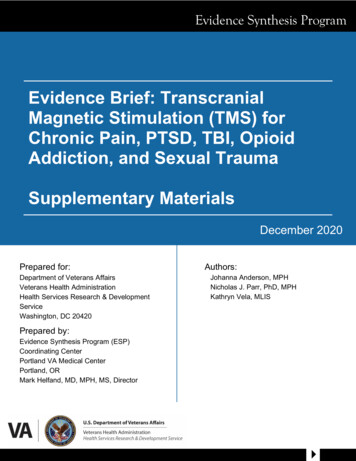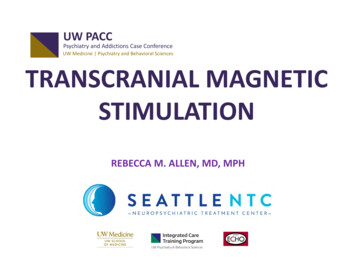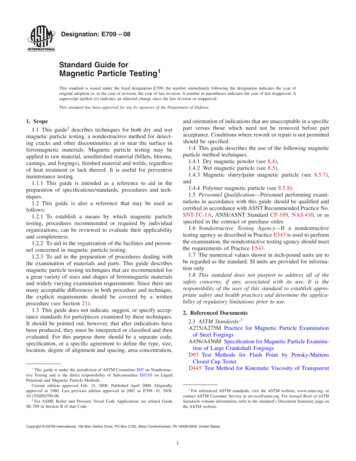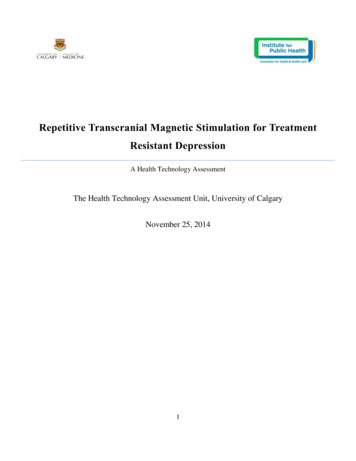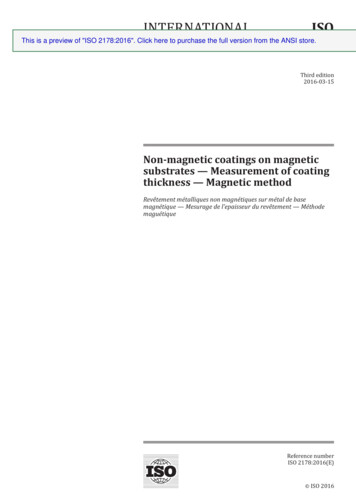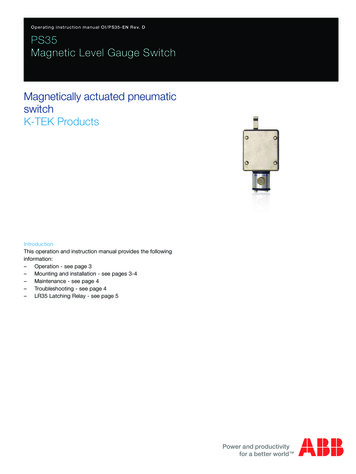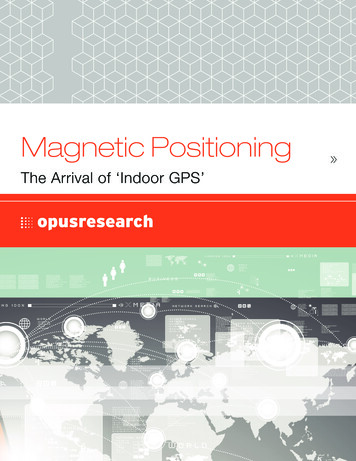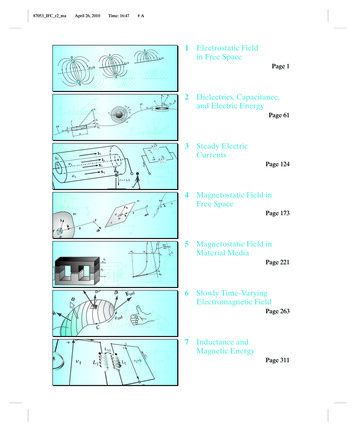
Transcription
Transcranial MagneticStimulationAlvaro Pascual-Leone, MD, PhDBerenson-Allen Center for Noninvasive Brain StimulationBeth Israel Deaconess Medical CenterHarvard Medical School
Electro-Magnetic Induction“I think I got hold of a good thing”M. Faraday29 August 1831
“Modern Era”Anthony Barker12 February 1985
House, MD [2006 season; Fox Television]
Noninvasive Targeting of Specific CorticalRegions: Frameless Stereotaxy
TMS Terminology Single pulse TMS single stimulus every 5-10 sec Paired pulse TMS subthreshold stim. then suprathreshold stim.stimuli separated by 1-20 msec Repetitive TMS (rTMS) trains of stimuli to one brain areaslow low frequencyfast (high freq) 1 Hz Asynchronous Repetitive TMS Intermittent or continuous Theta Burst
A Clinical TestMotor Central Conduction Time
A Clinical TestMotor Central Conduction Time
Another Clinical Test:Paired-pulse studies
Induction of speech arrest
Induction of paraphasic errors
Transcranial Magnetic Stimulation (TMS)
Topographic PrecisionScalp markersStereotaxyGugino et al. Clin Neurophysiol 2000
Topographic resolution
Mechanism of action
Mechanisms of action:Interaction between induced current and axons
Mechanism of action:Interindividual variability
DSI-Guided TMS ?Computed TMSinteraction with cerebralwhite matter- circular 10 cm TMS coil oververtex- DTI of cerebral white matterorientation, coronal slab- induced axonal EMF’scomputed with “antenna”model: d E,s /dsred , blue -Van Wedeen et al.
Magnitude of Induced CurrentHumans:measured 12µA/cm21 cm from coil7% of max. output intensityWagner et al., Neurosci Lett 2003
Modeling allows to understand the influence oftissue characteristics on current distributionMagnetic field penetrates skin, scalp and skull practically without attenuationThe induced electric field exerts the effects (electrodeless-electric stimulation)Wagner et al. IEEE 2005; Neuroimage 2006
The relationship between thecurrent density inside and outsidethe brain depends on individualtissue properties.
Current density varies throughout thebrain due to differences in impedanceand tissue geometrySkullCSFBrain every brain is different!Wagner et al.
Current densities in the healthy andpathological brain are not equivalentGray MatterHealthy BrainCSFSkullCSFStroke ModelCSFPathologyRelevant for safety, accuracy,and efficacyWagner et al.Brain Brain and every pathology is different!
Current densities in the brain are what matterCurrent densities in the brain affect neural functionin a complex and state dependent manner At least report sufficient data to be able to allow offlineFor TMS– coil position– coil orientation– coil geometry and material– current over time– available subject data Computational tools can be used to determine the relative focality, orientation,penetration, and intensity of current densities across subjects/studies. Knowing current density distribution is a necessary, but notsufficient to determine biological, behavioral, and safety effects
EFFECTS OF TMS ARISE FROM THEINTERACTION OF THE STIMULUSWITH THE TISSUE - CONSIDERTISSUE CHARACTERISTICSBRAIN STRUCTURES MAY SERVE ASANTENNAS (PICK-UP COILS) OF THEMAGNETIC FIELD - ORIENTATION !
THE EFFECTS OF TMS DEPEND ON THESTATE OF BRAIN ACTIVITYJohansson 1973
Neural correlates of biological motion perceptionGrossman & Blake, Neuron 2002
Neural correlates of biological motion perceptionGrossman, Batelli,Batelli, Pascual-Leone Vision Res 06
Effects of cortical stimulation depend onfunctional state of targeted cortexIOn mpalin ct oeT fMSDoes suppression of V5/MT by rTMS change the impact of Online TMS?fotcaImp TMSenilfTOfM/5VoTConsequence ofState Change in V5/MTSilvanto,Silvanto, Batelli,Batelli, Pascual-Leone J Neurophysiol 08
State Dependency For Specific Neural PopulationsTMS-adaptation paradigm and motion directiondiscrimination in visual area V5/MTCattaneo & Silvanto Neurosci Lett 08
State Dependency For Specific Neural PopulationsTMS-adaptation paradigm and motion directiondiscrimination in visual area V5/MTTMS disrupts non-adaptedbut improves adapteddirection discriminationCattaneo & Silvanto Neurosci Lett 08
Interaction with tissue depends onTMS parameters &level of activity of targeted cortexMoliadze et al. J. Physiol. 2003
Effect of TMS on neuronal activitymodulated by visual stimuliVisual TMS(late)TMS aloneVisual TMS(early)Moliadze et al. J. Physiol. 2003
Why is state-dependency useful? The behavioral impact of TMS depends onthe initial activation state– TMS behaviorally facilitates the attributesencoded by the adapted neural populationsrelative to attributes encoded by other neurons Enables differential stimulation of distinctneural populations in the targeted region Can enhance functional resolution of TMS– From causality to neural selectivitySilvanto & Pascual-Leone Brain Topogr 08
THE EFFECTS OF TMS DEPENDON THE ONGOING BRAINACTIVITY (BRAIN STATE) CONTROL BRAIN STATE !
EEG Gated TMSU.S. Patent No. 09/067,111Foreign Patent License BO662/7012
BIOLOGICAL EFFECTS EXTENDALONG SPECIFIC NEURALNETWORKS DEFINED BYANATOMICAL CONNECTIVITY
1 Hz rTMSSVA Splenial visual area Cg CingulateValero-CabréValero-Cabré et al Exp Brain Res 05
Valero-CabréValero-Cabré et al Exp Brain Res 05; 06Area 17SuperiorColliculusArea 19PULLPlLPiLGNLGN*MGNMGNSplenial visual areaLateral Post.Complex
Valero-CabréValero-Cabré et al Exp Brain Res 05
Real-Time TMS-fMRIIn-Vivo Studies of ConnectivityBehavioral IndependenceU.S. Patent No. 09/096,725Foreign Patent License BO662/7013
TMS TO MEASURE PLASTICITY
Measuring LTP/LTD in HumansTheta Burst Stimulation (TBS)TestTestIntervention: cTBS or iTBScTBSiTBS2s8s200 msBurst of 3 pulsesat 50 HzHuang et al. 2005
Hyperplasticity in AutismSpectrum DisordersMEP amplitude[proportion of baseline]iTBScTBSTime after TBS [min]
Intermittent TBS (iTBS)BeforeAfterEsser et al. 2006
LOCAL BIOLOGICAL EFFECTSDO NOT ACCOUNT FOR THEBEHAVIORAL IMPACT
Off-line rTMS: Differential local impactdepending on stimulation frequencyShamTMS1 HzTMS20 HzTMSValero-CabréValero-Cabré et al Exp Brain Res 07
Same behavioral consequences despiteopposite local impactValero-CabréValero-Cabré,Rushmore, et alBoston University Laboratory for Cerebral Dynamics, Plasticity & RehabilitationHF High frequency rTMS 1&2LF Low Frequency rTMS 1&2SH Sham rTMS 1&2
BEHAVIORAL EFFECTS OF TMSREFLECT THE CAPACITY OFTHE REST OF THE BRAIN TOADAPT TO THE FOCALDISRUPTION
BeforeAfterShamrTMS1 HzrTMS10 HzrTMSrTMS to M1; subthreshold intensity; 1600 stimuli
Maintained Behavior Despite Disruption ByRapid Shifts in ConnectivityLi et al. J Neurosci
BRAIN STIMULATIONPROVIDES INSIGHTS THATCANNOT BE OBTAINED WITHOTHER TECHNIQUES
TMS: Interfering with Brain Function Brain Imaging ‘helping’ TMS– Localization– Timing Multimodal Integration ofTMS– Causality– Chronometry– “Behavioral-independent”Connectivity– Adaptation
Activation of the Striate Cortex in theCongenitally BlindSadato et al. Nature 1996
Activation of the Striate Cortexis Necessaryfor Braille Reading in the Blind:Serendipity of Nature 63 y/o womanBlind “since birth”Braille since age 7Braille 4-6 h/dUnable to readBraille after transientcoma Normal neurologicalexamHamilton et al. Neuroreport 2001
Activation of the Striate Cortexis Necessaryfor Braille Reading in the Blind:Virtual Lesion (rTMS) ExperimentCohen et al. Nature 1997
Detection and Identification of BrailleSymbols in Congenitally BlindHamilton et al.TICS 1998
Transcranial Magnetic Stimulation Electromagnetic Induction Effects of TMS arise from the interaction with the tissue– Dose according to current density Effects depend on the state of brain activity– Opportunity for selectivity of effect Biological effects extend along specific neural networks definedby anatomical connectivity– Diagnostic Utility– Inform study designs and interpretations Local biological effects do not account for behavioral impact TMS can provide insights that cannot be obtained with othermethods
TMS Terminology Single pulse TMS single stimulus every 5-10 sec Paired pulse TMS subthreshold stim. then suprathreshold stim. stimuli separated by 1-20 msec Repetitive TMS (rTMS) trains of stimuli to one brain area slow low frequency fast (high freq) 1 Hz Asynchronous Repetitive
